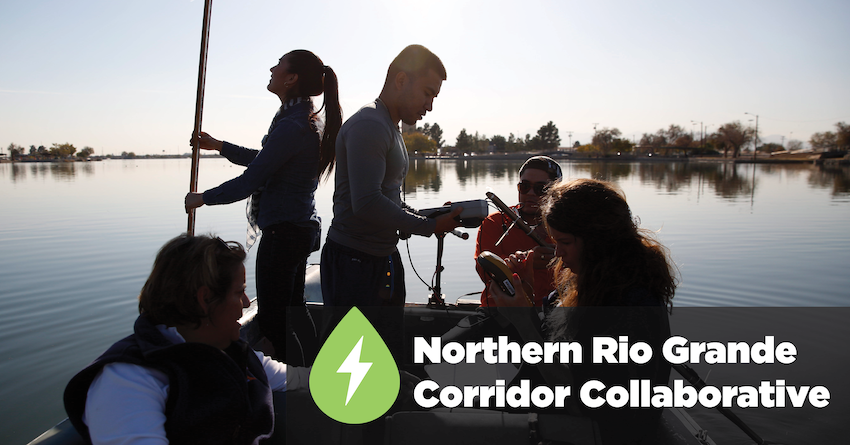
Northern Rio Grande Corridor Collaborative Unveils Plan to Prepare for Regional Water, Energy and Climate-Based Challenges
Last Updated on July 13, 2022 at 12:00 AM
Originally published July 13, 2022
By MC Staff
UTEP Marketing and Communications
Project underpinned by application for federal grant of up to $160 million

EL PASO, Texas (July 13, 2022) — The Northern Rio Grande Corridor Collaborative (NRGCC), a consortium that includes two national laboratories and five universities, announced today it has submitted a proposal for potential federal funding to advance energy and water research in the arid Southwest.
The NRGCC is a research partnership dedicated to the advancement of discovery and its application in the areas of climate science, water and clean energy. The group submitted a concept outline on June 30 to the National Science Foundation (NSF) as the initial formal step in its application for a Type-2 award from the NSF Regional Innovation Engines program. These awards are expected to offer recipients up to $160 million in funding over a 10-year period.
The NRGCC includes seven institutions: Navajo Technical University (NTU), New Mexico State University (NMSU), New Mexico Tech (NMT), the University of New Mexico (UNM), The University of Texas at El Paso (UTEP), Los Alamos National Laboratory (LANL), and Sandia National Laboratories (Sandia).
“Our vision is to lead the invention and commercialization of technologies that bring clean water to every tap, decarbonized power to every door, and an inclusive and vibrant economy to our region,” said Jim Chavez, acting director of the NRGCC. “Our innovation ecosystem is uniquely well-positioned to effectively apply resources, including any that may come from the NSF Engines program, to quickly translate these innovations to practice.”
Collaboration on Regional Challenges
The collaborative was built on the commitment to do more together than any of the partners can do alone. Together, the institutions employ almost 16,000 scientists and engineers, and conducted $6.6 billion of research, $484 million of which was performed within the NRGCC universities. These universities enroll over 64,000 students, 79% of whom are minorities.
The Northern Rio Grande Corridor stretches from the New Mexico-Colorado border to El Paso, Texas. Northwest of the Rio Grande Valley is the San Juan Basin, the largest coal-bed methane field in the world. Southeast of the valley is the Permian Basin, the most prolific hydrocarbon production region in the U.S., accounting for 30% of the oil and 14% of the gas produced in America.
Although rich in carbon-based energy, the region also provides significant wind, solar, and geothermal energy and is home to many of the nation’s most talented nuclear engineers through our national laboratories.

Water Management
The concept paper submitted by the collaborative proposes improvements to small-scale wastewater treatment; development of innovative technologies for small-scale rainwater capture and removal of noxious materials from contaminated soils and waters; innovations in water desalination, treatment and reuse; and the promotion of modern agricultural techniques such as the use of brines to cultivate salt-tolerant crops and precision irrigation.
“Water scarcity poses a major constraint to health and prosperity to drylands in our region and around the world,” said Thenral Mangadu, Ph.D., UTEP associate vice president for interdisciplinary research and the university’s representative in the collaborative. “That is why the NRGCC aims to increase the resilience of the clean water supply to climate change and lower the cost of clean water.”
Sustainable Energy
To enable a transition to a modern, secure and sustainable electric grid across the region, the collaborative plans to support the solar supply chain and accelerate regional manufacturing of photovoltaic components, foster innovation in microgrids for localized energy centers, amplify existing wind power with technological innovations, and expand geothermal capacity for greenhouses and for aquaculture.
As Chavez, the collaborative’s acting director, explained, a plan of such breadth and scope will benefit immeasurably from the level of resources that an NSF Engines Type-2 award can provide. The NSF expects to complete all approvals of concept outlines by Aug. 1, 2022. If the collaborative’s initial submission is accepted, the next step will be to submit a full proposal in fiscal year 2023, which begins in October 2022. The NSF has not set a specific deadline for submission of full proposals, nor has it said when it will announce which of those proposals will receive funding.
To learn more about the NRGCC and its mission, visit nrgcc.org.
